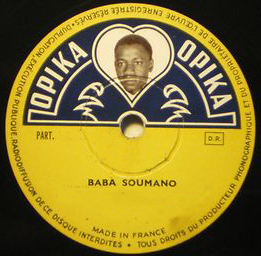Baba Soumano: "Aponsa"
Graeme Counsel © Copyright
Here is Baba Soumano and his ensemble performing “Aponsa”, from circa 1954.
Soumano's musical style was inventive and modern yet firmly based in traditiion. He was quite the songster, recording at least 53 sides which ranged from popular songs (“Mano whisky soda”, “Produits zazou”, “Ça va barder!”) to the tradition music of the griots of the Mandé (“Douga”, “Soumdiata”, “Namfoulé”, “Diarabi”, “Kaïra”). In “Aponsa” he presents a song from the Highlife/Palm-wine musical genre which was popular throughout West Africa. Originally recorded by Ghana’s Kumasi Trio in 1928 in London as “Yaa amponsa”, which was a smash hit and remains the template upon which Highlife/Palm-wine music was built, Soumano's version is faithful to original while adding some contemporary twists.
Soumano approaches the song by removing the claves that were a feature of the 1928 original and adding a melodica. He also replaces the original lyrics with those from “Mami wata”, and in that regard his version seems influenced by another famous highlife artist, Kwaa Mensah - "the king of palm-wine" - who was prolific in the 1940s and 1950s. Kwaa Mensah’s recording of “Mami Wata” is clearly echoed in Soumano's version, thus Soumano presents “Aponsa” as a bridge between “Yaa amponsah” and “Mami wata”.
For many Malians, the songs “Yaa amponsah” and “Mami wata” are one in the same, as Salif Keita confirms in Nathaniel Braddock’s thesis “’You can’t run away from it! The melody will always appear!’ Yaa amponsah and the rhythm at the heart of West African guitar” (2020). Racanelli (“Formulaic variation procedures in Mande griot guitar playing and improvisation”, 2012) goes further, stating that “Mami wata” first appeared as “Ya Amponsah” in the repertoire of Highlife/Palm-wine bands. Perhaps this is what Soumano is suggesting in his version of “Aponsa”, that Highlife/Palm-wine music has deep (Mandé) roots indeed.
These broad musical influences on Malian musicians in the mid 20th century reflect the wider impact of the Highlife/Palm wine musical style throughout West Africa. In “The early history of West African highlife” (1989), John Collins notes that in the 1930s over 200,000 78 rpms of Palm-wine music were being sold each year. It's influence on popular musical styles from Sierra Leone to Nigerian was thus profound.
I must add that I am not entirely certain that the melodica is the featured instrument in many Baba Soumano songs, such as in “Aponsa” at 0’38” (and especially in “Alanolé”). It sounds like a melodica, but I am not 100% sure. Here, however, is a clip of a melodica version of “Yaa amponsah”, which gives a good clue.
Enjoy "Aponsa" by clicking on the image below.
| Baba Soumano |
 |
| “Aponsa” |